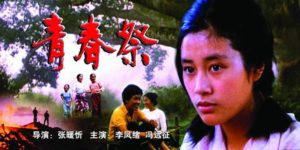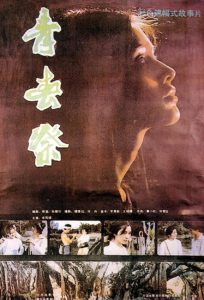Sacrifice of Youth
青春祭
China, 1985, colour, 1.66:1, 96 mins.
Director: Zhang Nuanxin 张暖忻.
Rating: 8/10.
Warm, relaxed portrait of the clash between Han and non-Han emotional values in a Dai village during the Cultural Revolution.
Yunnan province, southern China, sometime during the Cultural Revolution (1966-76). Following her father’s exile into hard labour, seventeen-year-old Li Chun (Li Fengxu) and fellow pupils of High School No. 24 are “sent down” to the countryside in the south and distributed throughout various villages of the Dai ethnic minority. Li Chun is put up in the home of rural co-operative head Da Die (Song Tao), who speaks Chinese and lives with his aged mother, Ya (Yu Shuai). His son, Da Ge (Guo Jianguo), is away hunting. The prudish Li Chun is shocked by the way that local girls openly flirt with local boys, and vice versa, and also by how the girls bathe naked in the river. She gets to know village beauty Li Bo (Yu Tan) but is not fully accepted by the local girls until she starts wearing Dai clothes, for which Ya gives her a traditional silver belt. Li Chun keeps in touch with her mother via letters sent through the local post office, where all the sent-down students go. One day she meets Ren Jia, a pupil from the same school, who’s been assigned to another village. In her own village Li Chun also attracts the attention of Da Ge when he returns from hunting.
REVIEW
 Within the framework of two popular genres (the ethnic minority film and Cultural Revolution critique), Zhang Nuanxin 张暖忻 examines a much deeper theme – the clash between the emotional values of Han and non-Han Chinese – in Sacrifice of Youth 青春祭. Set amidst the Dai people of southern China, whither a 17-year-old Beijing girl has been sent for “re-education”, the film charts the gradual breakdown of her strict northern values in the face of the Dai women’s more relaxed attitudes to sex and life in general. As in Girl of a Good Family 良家妇女 (1985) or Swan Song 绝响 (1985), political developments in the “outside” world are alluded to rather than shown explicitly. And although the Dai community finally rejects her because of the unbridgeable gulf, each is left with an indelible mark of their common experience.
Within the framework of two popular genres (the ethnic minority film and Cultural Revolution critique), Zhang Nuanxin 张暖忻 examines a much deeper theme – the clash between the emotional values of Han and non-Han Chinese – in Sacrifice of Youth 青春祭. Set amidst the Dai people of southern China, whither a 17-year-old Beijing girl has been sent for “re-education”, the film charts the gradual breakdown of her strict northern values in the face of the Dai women’s more relaxed attitudes to sex and life in general. As in Girl of a Good Family 良家妇女 (1985) or Swan Song 绝响 (1985), political developments in the “outside” world are alluded to rather than shown explicitly. And although the Dai community finally rejects her because of the unbridgeable gulf, each is left with an indelible mark of their common experience.
 [Adapted from the 1982 novella There Was a Beautiful Place 有一个美丽的地方 by Zhang Manling 张曼菱 (see cover, left),] Zhang’s second feature is a major advance on her earlier sports melodrama The Drive to Win 沙鸥 (1981). Born in 1940, and a teacher at Beijing Film Academy, she is a good example of a director who, though not technically a member of the “Fifth Generation”, is still at the forefront of changes sweeping through Mainland film-making. [Zhang died in 1995, aged 54.] Sacrifice of Youth has a warm, relaxed feel which never tips over into either melodrama or picturesqueness for their own sakes. Only at the very end, with a lachrymose song, does the finely detailed atmosphere stumble.
[Adapted from the 1982 novella There Was a Beautiful Place 有一个美丽的地方 by Zhang Manling 张曼菱 (see cover, left),] Zhang’s second feature is a major advance on her earlier sports melodrama The Drive to Win 沙鸥 (1981). Born in 1940, and a teacher at Beijing Film Academy, she is a good example of a director who, though not technically a member of the “Fifth Generation”, is still at the forefront of changes sweeping through Mainland film-making. [Zhang died in 1995, aged 54.] Sacrifice of Youth has a warm, relaxed feel which never tips over into either melodrama or picturesqueness for their own sakes. Only at the very end, with a lachrymose song, does the finely detailed atmosphere stumble.
[There is no English title on the film, which is also known as Sacrificed Youth.]
CREDITS
Presented by Beijing Film Academy Youth Film Studio (CN).
Script: Zhang Nuanxin. Novella: Zhang Manling. Photography: Mu Deyuan, Deng Wei. Editing: Zhao Qihua. Music: Liu Suola, Qu Xiaosong. Music direction: Hu Binxu. Vocals: Wu Jing, Qu Xiaosong. Art direction: Li Yongxin, Wang Yanjin. Costumes: Zhao Hui. Sound: Ma Yuewen.
Cast: Li Fengxu (Li Chun), Feng Yuanzheng (Ren Jia), Song Tao (Da Die, Li Chun’s landlord), Guo Jianguo (Da Ge, Da Die’s son), Yu Shuai (Ya, Da Die’s mother), Yu Tan (Yi Bo), Zhu Lanfang, Yan Hamu, Wen Liaojiang, Yan Hamubin, Mao Xiang.
Release: China, 18 Jun 1985.
(Review originally in China section of UK annual International Film Guide 1987, published in Nov 1986. Modern annotations in square brackets.)
